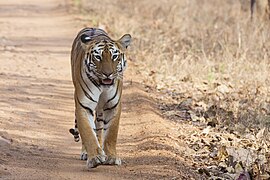Plagiorhynchidae
| Plagiorhynchidae | |
|---|---|
| Scientific classification | |
| Kingdom: | Animalia |
| Phylum: | Acanthocephala |
| Class: | Palaeacanthocephala |
| Order: | Polymorphida |
| Family: | Plagiorhynchidae Golvan, 1960 |
Plagiorhynchidae is a family of parasitic Acanthocephalan worms.
Species[]
Genera in Plagiorhynchidae are divided into three subfamilies: Plagiorhynchinae, Porrorchinae, and Sphaerechinorhynchinae.[1][a]
Plagiorhynchinae Meyer, 1931[]
Paralueheia Saxena & Gupta, 2008
- Paralueheia guptai Saxena & Gupta, 2008
Species in Plagiorhynchus are divided into two subgenera: Plagiorhynchus and Prosthorhynchus.[2]
Plagiorhynchus Lühe, 1911[]
- Smales, 2002
- [3]
P. aznari was found infesting a long-billed curlew (Numenius americanus) from northern Mexico.[3]
- Yamaguti, 1939)
- Dollfus, 1953)
- Villot, 1875)
- Vicente, 1977
- Muti-ur-Rahman, Khan, Khatoon and Bilqees, 2008
- Belopolskaya, 1958
- Westrumb, 1821)
- Johnston, 1912)
- Lundström, 1942
- Van Cleave and Williams, 1950
- de Marval, 1902)
- Lisitsyna, 1992
- Linton, 1892)
- Porta, 1910)
- de Marval, 1902)
- Porta, 1910)
- Cameron, 1936)
Prosthorhynchus Kostylew, 1915[]
- Travassos, 1926)
- Gupta and Lata, 1967)
- Belopolskaya, 1983)
- Schmidt and Kuntz, 1966
- Smales, 2010
- Goeze, 1782)
P. cylindraceus was found infesting the Austral thrush (Turdus falcklandii) in central Chile.[4] Janice Moore[5] discovered P. cylindraceus to be a parasite that infects an intermediate host, the terrestrial isopod Armadillidium vulgare, which alters its behavior and becomes more susceptible to P. cylindraceus' primary host, the European starling (Sturnus vulgaris).
- Bhattacharya, 2002
- Amin, Ha and Heckmann, 2008
- Schachtachtinskaja, 1953)
- Lundström, 1942)
- Schmidt and Kuntz, 1966
- Petrochenko, 1958)
- Gupta and Fatma, 1988
- Tubangui, 1933)
- Travassos, 1926)
- Travassos, 1916)
- Tubangui, 1935)
- Amin, Ha and Heckmann, 2008
- Soota and Kansal, 1970)
- Fukui and Morisita, 1936)
- Tubangui, 1935)
- Westrumb, 1821)
- de Marval, 1902)
- Kostylew, 1915)
- Tadros, 1970
- Golvan, 1994)
- Kostylew, 1915)
- Rudolphi, 1819)
- Wang, 1966)
Porrorchinae Golvan, 1956[]
- Lueheia Travassos, 1919
- (Werby, 1938)
- Machado-Filho and Ibanez, 1967
- (Westrumb, 1821)
L. inscripta was found infesting the Austral thrush (Turdus falcklandii) in central Chile.[4] It has also been found in the Puerto Rican lizard Anolis cristatellus.[6]
- Khan, Bilqees and Muti-ur-Rahman, 2005
- Travassos, 1919
- Oligoterorhynchus Monticelli, 1914
- (Nitzsch, 1857)
- Owilfordia Schmidt and Kuntz, 1967
- Schmidt and Kuntz, 1967
- Gupta and Fatma, 1988
- (Van Cleave, 1949)
- Porrorchis Fukui, 1929
- Smales, 2010
- (Southwell and Macfie, 1925)
- (Das, 1949)
- (Porta, 1910)
- (Tubangui, 1933)
- Gupta and Fatma, 1986
- Gupta and Fatma, 1986
- Fukui, 1929
- Bilqees, Khan, Khatoon and Khatoon, 2007
- Bhattacharya, 2007
- (Joyeux and Baer, 1935)
- (Edmonds, 1957)
- (Johnston, 1914)
- (Das, 1957)
- Muti-ur-Rahman, Khan, Khatoon and Bilqees, 2010
- George and Nadakal, 1984
- Lisitsyna, Tkach and Bush, 2012
- Schmidt and Kuntz, 1967
- (Golvan and Brygoo, 1965)
- Salgado-Maldonado and Cruz-Reyes, 2002
- Yamaguti, 1939
- (von Linstow, 1897)
- Amin, Ha and Heckmann, 2008
- Pseudogordiorhynchus Golvan, 1957
- Pseudogordiorhynchus antonmeyeri Golvan, 1957
- Pseudolueheia Schmidt and Kuntz, 1967
- Bhattacharya, 2007
- (Van Cleave and Williams, 1951)
- Gupta and Fatma, 1988
- Schmidt and Kuntz, 1967
- Salcedo and Celis, 2007
Sphaerechinorhynchinae Golvan, 1956[]
- Sphaerechinorhynchus Johnston, 1929
- Amin, Wongsawad, Marayong, Saehoong, Suwattanacoupt and Say, 1998
S. macropisthospinus has been found in the intestine of the tiger (Panthera tigris) and a water monitor (Varanus salvator) in Vietnam.[7]
- Amin, Ha and Heckmann, 2008
- Bolette, 1997
- (Johnston, 1912)
- Schmidt and Kuntz, 1966
Hosts[]
Plagiorhynchidae species parasitize a variety of hosts.
- Hosts for Plagiorhynchidae species

The Long-billed curlew is a hosts of Plagiorhynchus aznari

The Austral thrush is a hosts of Plagiorhynchus cylindraceus and Lueheia inscripta

The Tiger is a hosts of Sphaerechinorhynchus macropisthospinus

The Asian water monitor is a hosts of Sphaerechinorhynchus macropisthospinus
Notes[]
- ^ A binomial authority in parentheses indicates that the species was originally described in a genus other than the present genus.
References[]
- ^ "ITIS - Report: Plagiorhynchidae".
- ^ "ITIS - Report: Plagiorhynchus".
- ^ a b García-Varela, M.; Park, J.-K.; Hernández-Orts, J.S.; Pinacho-Pinacho, C.D. (2020). "Morphological and molecular data on a new species of Plagiorhynchus Lühe, 1911 (Acanthocephala: Plagiorhynchidae) from the long-billed curlew (Numenius americanus) from northern Mexico". Journal of Helminthology. 94: e61. doi:10.1017/S0022149X19000543. PMID 31328706. S2CID 198135203.
- ^ a b Llanos-Soto, Sebastián; Córdoba, Mabel; Moreno, Lucila; Kinsella, John Mike; Mironov, Sergey; Cicchino, Armando; Barrientos, Carlos; Martín-Ordenes, Julio San; González-Acuña, Daniel (July 2019). "External and intestinal parasites of the Austral thrush Turdus falcklandii (Aves, Turdidae) in central Chile". Revista Brasileira de Parasitologia Veterinária. 28 (3): 432–442. doi:10.1590/s1984-29612019067. PMID 31531671.
- ^ Moore, Janice (October 1983). "Responses of an Avian Predator and Its Isopod Prey to an Acanthocephalan Parasite". Ecology. 64 (5): 1000–1015. doi:10.2307/1937807. JSTOR 1937807.
- ^ Hailey, Adrian (21 November 2019). "Anolis cristatellus (Puerto Rican crested anole)". Invasive Species Compendium. CAB International. Retrieved 4 February 2020.
- ^ Amin, Omar M.; Ha, Ngyuen Van; Heckmann, Richard A. (2008). "New and Already Known Acanthocephalans Mostly from Mammals in Vietnam, with Descriptions of Two New Genera and Species in Archiacanthocephala". Journal of Parasitology. 94 (1): 194–201. doi:10.1645/GE-1394.1. PMID 18372641. S2CID 7767259.
- Plagiorhynchidae
- Polymorphida
- Acanthocephala families



